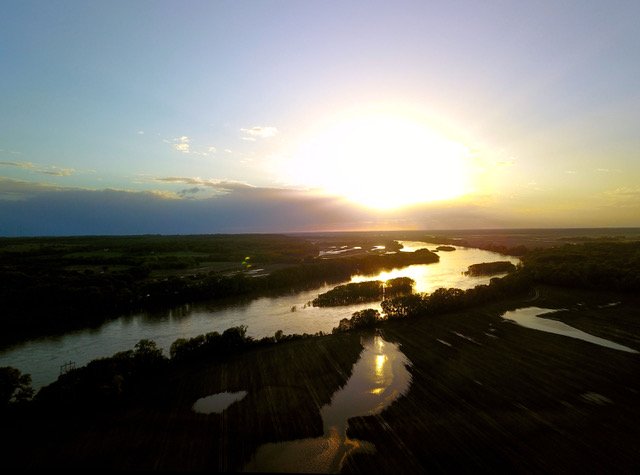
NOTE: As of Friday, May 31st, officials warned of a potential evacuation for the town of Manhattan, Kansas, because of elevated levels at the Tuttle Creek Reservoir.
Dawn Buehler, Kansas Riverkeeper and Executive Director of Friends of the Kaw, lives on a small farm south of the Kansas River, which she said is currently a “mud pit.”
“It started raining here last September and between rain and snow, it hasn’t stopped,” she said. Over the past few weeks, in particular, she’s witnessed historic and devastating floods, exacerbated by tornadoes – some visible from her front porch.
A few weeks ago, when reservoirs were already over half full, Dawn attended a meeting hosted by the Army Corps of Engineers to discuss Tuttle Creek Reservoir. The Army Corps manages the dams and controls the flow of water in and out of reservoirs along the Kansas and Missouri Rivers. Tuttle Creek Reservoir is nearing capacity, which would require releasing flood water into the Big Blue River, which meets the Kansas River, to maintain the maximum designated water level for the reservoir. Reservoirs all along the Mississippi face this same challenge.
Dawn and many Kansans have grown frustrated with the Corps’ adherence to “the manual,” an outdated rulebook for flood management. The Army Corps of Engineers said the rulebook hasn’t been updated since 1964 for Tuttle Creek Reservoir, despite record rainfall this year. “Some people would say this year is not normal,” she said. “But a lot of us would say this is the new normal; it’s what we’re going to see with a rapidly changing climate.”
Also frustrating Dawn and many Kansans: the bottleneck at Waverly, Missouri, a small town of 837 downstream that floods on a regular basis. The Army Corps rules for releasing floodwater upstream in Kansas depend on the status of the Missouri River downstream in Waverly. By adhering to the manual, all four reservoirs on the Kansas River mainstem tributaries that hold flood water at or near capacity. Three are full, and will soon release more water to an already flooded Missouri and Mississippi river system.
Kansans are on edge; the flooding and recent tornadoes took a serious toll, and the reservoirs at capacity remind them of the build-up to the particularly devastating flood of 1993. Currently, Kansans face flooding in low areas along the Big Blue River and Kansas River, a failing dam in Sabetha that could potentially increase flooding on the Delaware River and Perry Reservoir, widespread evacuation advisories, a loss of potentially $6 million to the state parks on Memorial Day Weekend, and an untold loss of tourism dollars to canoe and kayak outfitters, fishing guides, bait shops and marina owners.
This week, the City of Manhattan announced that the Country Stampede music festival, one of their biggest events of the year, will be moved to Topeka after 24 years in Manhattan, Kansas, due to extreme flooding. This is a loss equivalent to $7 million to the community. “This doesn’t even count what is happening in the Arkansas River watershed in the southern part of Kansas with heavy flooding and swollen rivers,” Dawn emphasized.
Dawn and her allies want the Army Corps to conduct a Missouri River Flooding Convenance Study to expand the bottleneck at Waverly, Missouri and update the rulebook accordingly. These updates to the rulebook, had they come sooner, would have allowed the Army Corps to release water earlier in the spring from the Kansas River reservoirs that are all currently at or near capacity, creating a safer situation for both Kansans and Missourians.
Dawn wonders why the Army Corps hasn’t made changes already, since Spring rains seem to catch them by surprise each year. “I think what it comes down to,” she said, “is that we are often forgotten in the big Missouri River system. What about Kansas?”
Dawn and her river partners hope that a Missouri River Flooding Convenance Study and an updated rulebook will answer some of their questions and help the too-often forgotten heartland better prepare for future Spring rains.
*Feature Photo by Lisa Grossman | A swollen Kansas River at Lecompton, 5.21.19